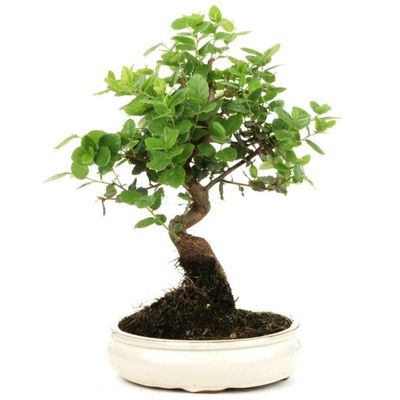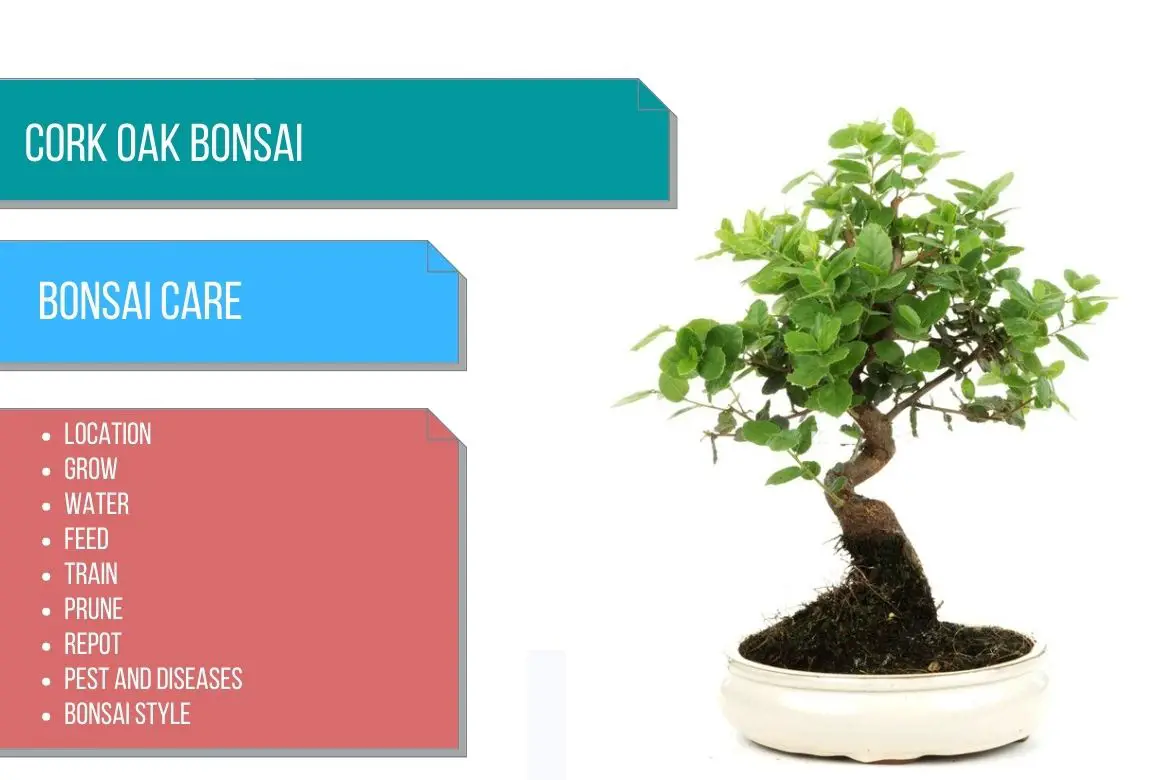
Cork oak
(Quercus suber)
Country of Origin : Europe
Bonsai Styles : Broom style, Informal upright
Zone : 8 – 11
Cork oak is a slow-growing, medium-sized Mediterranean evergreen tree.
The tree has a knotty growth habit.
The tree has outstanding deeply furrowed, thick and rugged corky bark.
It has persistent, alternate, and simple leaves, with a pointed tip. The leaves are dark green above and gray-green below.
Its alternate leaves closely resemble those of an evergreen oak (Quercus ilex – Holly oak or holm oak), though they are less toothed.
Can you make a cork oak bonsai?
Yes. For bonsai, cork oak trees are very popular. It is well suited to styling as a bonsai due to its rugged bark and small leaves. However, I would not recommend this tree for beginners as extra care has to be taken to maintain the conditions in which the tree thrives. You should only choose young plants when you are collecting your own specimens from the wild, because older plants are not able to withstand hard branch and root pruning.
When it comes to growing Quercus suber tree as a bonsai, the species looks best when it is grown as a large bonsai, due to the large size of its trunk. It is suitable for most bonsai styles, except windswept.
Is Cork oak fast growing?
No. It is a slow growing tree.
I have made a list of oak tree varieties which can be used to make bonsai in the care guide of English oak bonsai tree.
Read more about other bonsai trees species in : Types of bonsai tree
Best location to keep Cork oak bonsai tree
Cork oak bonsai can be treated as an outdoor bonsai tree and indoor bonsai tree. A bonsai tree’s placement obviously depends on the geographical location.
For example, in Mediterranean countries cork oak bonsai can be kept in full sun throughout the year as long as they are protected from the worst of winter weather.
On the other hand, if you live in a temperate area, you will need to keep them under cover and protected from the elements as you would indoor bonsai over the winter. The bonsai must be moved to a heated greenhouse where they will be kept under cover until the end of spring.
In general, place the bonsai in a bright location all year round with plenty of sunlight.
Throughout the spring and autumn, cork oak bonsai can be kept outdoors on a balcony or in a garden, as well as on a terrace.
The bonsai should be brought indoors and placed in a bright, cool area as soon as the first frost is expected.
Place it in a location with high humidity.
IMP: Refer to do bonsai trees need sunlight for more indoor and outdoor bonsai location ideas. Also, refer sunlight requirements for indoor plants for more indoor gardening ideas.
Propagation of Cork oak bonsai tree
Wild seeds should be sown immediately, and seedlings should be kept unheated during the winter. It is not easy to propagate from cuttings, but it is still possible.
Watering Cork oak bonsai tree
As the oak grows, make sure to water it throughout the growing season, increasing the amount of water if necessary during the summer.
You can use tap water. The tree will cease growing if water is not enough.
It is important not to water the soil surface in winter until it has dried out just a bit.
Read watering bonsai tree for more details.
Wiring Cork oak bonsai tree
It is easiest to trim and wire the tree into upright and broom styles, which are closest to the tree’s natural habit. Training will have to start early if you plan to take on a more radical style.
1 and 2 year old branches can be wired without difficulty.
Branches can be wired in spring or summer, but the wire should only be applied to shoots from the previous year that have hardened, to avoid scarring.
However, wires placed in the month of spring should only be left on the tree for 3 months (Depends on the growth of the tree as well, just keep checking the wires). Or else they will become too tight. The branch will need to be rewired if it has not yet grown into the required position.
Make sure that you protect the branch. Older branches should be guyed down.
Read : Detailed guide on How to wire a bonsai. This extensive guide includes all the wiring techniques and Do’s and Dont’s. It will also show you other bonsai training techniques which can be achieved without using wires.
Pruning Cork oak bonsai tree
When to prune Cork oak bonsai tree?
How to prune Cork oak bonsai tree?
Cork oaks respond well to hard pruning. Hence, large bonsai specimens can be made from nursery material by cutting trees back to 30-60 cm (1-2 ft).
Pruning is possible at any time of the year for this species.
New shoots on young plants that are still being trained should be allowed to reach a length of 20 cm (8 in) before they are pruned back to between one and five leaves, depending on their position in the crown. Branches of mature and well-established bonsai trees can be pruned earlier.
It is also necessary to pinch out the tree during the growing season in order to keep the tree looking trim at all times. As soon as two or three leaves appear on the growing tips, pinch them out.
Read how to prune a bonsai to know about the right technique of pruning and more about defoliating a bonsai tree.
Repotting Cork oak bonsai tree
When to repot Cork oak bonsai tree?
Repot cork oak bonsai every two or three years during spring, when the buds are about to open.
For young bonsai trees, you should replace 2/3 of the bonsai soil (if not changing the whole soil). However, you can leave older bonsai trees in the same soil for a longer period of time.
The roots should only be slightly pruned. The tap-root should be gradually pruned back at each repotting, leaving a good root system.
Use a fairly deep bonsai pot for cork oak.
Use a good-quality, moisture-retentive but free-draining Bonsai soil mix.
You can also use sand or fine gravel, fired clay particles, and peat (or garden compost) in the ratio of 1:1:1.
Or a mix of 40% coarse sand and 60% soil can also be used.
Please check out how to repot a bonsai to know everything about repotting and root pruning a bonsai.
Must Read: Bonsai Soil Recipes
Must read : Choosing the right bonsai container
Feeding Cork oak bonsai tree
During the period between early spring and mid-autumn, young bonsai trees should be fed generously with organic or inorganic fertilizer at least every two weeks. By doing this, you will encourage the growth of the tree, and with it, the development of the bark as well.
In the case of older plants, which have already developed a good bark, it is better to feed them less frequently.
In winter, do not feed at all.
Read more about bonsai fertilizer and its application.
Diseases and pest of Cork oak bonsai tree
The cork oak is usually not very susceptible to pests.
Aphids and scale insects may occasionally infest cork oak, but systemic insecticides can be used to control them if they are too many to manually remove.
There is also the possibility of mildew. Remove and burn affected leaves, and spray with fungicide if necessary.
Our comprehensive guide: How to identify and treat bonsai pests and diseases is a great resource for you to see all the organic and inorganic remedies you can use.

